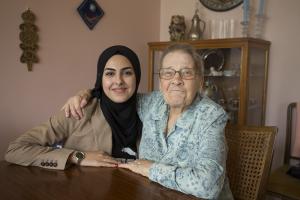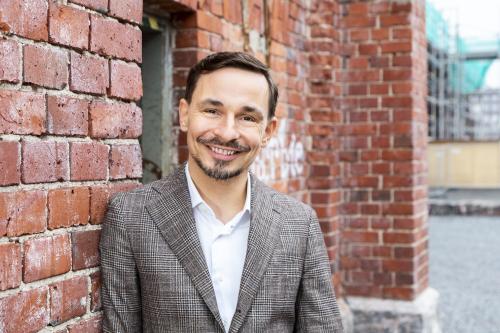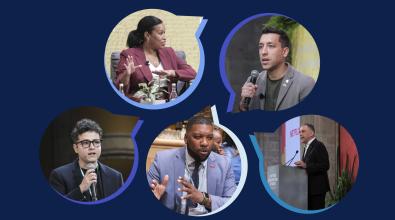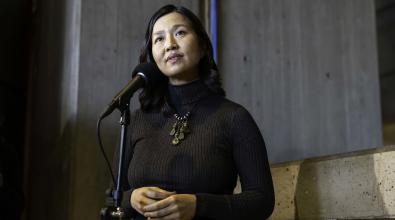4 lessons on listening to residents

Participants in Migrant Youth Helsinki, a project aimed at boosting social, economic, and educational opportunities for young migrants that was built on their own ideas and insights.
As the Bloomberg Center for Public Innovation at Johns Hopkins University ramps up supports for cities, it is tapping the expertise of innovators like Helsinki’s head of culture and leisure, Tommi Laitio.
Laitio, who is taking a two-year leave from the city to work as a fellow at the Bloomberg Center, has a wealth of knowledge to share. In less than a decade, he has led the delivery of more than 100 million resident experiences with city government, from book loans to symphony concerts to visits to the city’s swimming pools.
His work has helped transform health, youth programming, and the global view on how city hall can impact the lives—and the wellness—of people. One of the secrets to his success? Listening to residents.
Building understanding and trust first, rather than jumping straight to solutions, opens up room for more people to get involved, builds equity, and leads to better results, he explains.
“When you go too quickly to developing solutions, you give more voice to the people and to organizations who are used to being listened to,” he says. “The people who have been undermined or marginalized may not speak up or may feel resentful toward government. Understanding their perspective is essential to design solutions that work for them.”
Laitio’s passions align with the Bloomberg Center for Public Innovation’s civic engagement practice, which is a core part of its approach to innovation. Here, he shares four strategies for listening to residents that have worked for him in Helsinki.
Focus on people, not just problems. “When I started as the Director of Youth Affairs in 2012, I felt that the language around youth was very problem-oriented," Laitio said. "In the public discussion, young people were either in the waiting room for adulthood, at a risk of marginalization or up to no good.”
Laitio and 350 team members roamed the streets of Helsinki and spoke with young people to understand how they could impact the narrative and services. Their first-hand feedback on what youth like about their neighborhoods and what they wanted from the city influenced a new mission for the department: to make Helsinki a place where young people have friends, have things to do, and feel like they matter to other people.
That simple, direct language was intentional—it reflected how youth spoke about themselves and what they wanted from their city.
“We really focused on their experience and not the problems we saw on our charts,” he said. “We always have more data on problems and service delivery than on aspirations and assets. It’s important to look beyond problems and see people as competent and responsible individuals who want to take their life forward.”
That commitment to engaging with residents to truly understand them has helped Laitio make an impact on his city and power the next phase of his career.
In 2016, Laitio became the first Executive Director of Culture and Leisure to merge seven departments into one. He worked with a team of 1,800 professionals and a budget of $270 million to deliver more than 20 million resident experiences a year, providing services ranging from youth programs to symphony concerts and an award-winning public library.
Don’t forget who you are trying to help. If you speak to Laitio about his work, he’ll tell you not just about what the city has accomplished, but about the people he’s met.
For example, he recalls meeting an elderly couple in their home while he was part of a team participating in the Bloomberg Innovation Track training program. The husband was suffering from dementia and couldn’t move on his own, so they relied heavily on help from the city of Helsinki’s senior care.
“Their home was really beautiful,” he said. “The lady had made us coffee, bought us chocolate.”
She told him how incredible to her it was that the city was interested in their everyday life.
“She said, ‘We’ve been married for 60 years and we love each other. And this is the stage of life that we’re in and we’re committed to loving each other in good and bad times.’”
And then she talked about the new library and how it brings her so much joy.
That experience stuck with Laitio. “Now every time I think about senior citizens and their health and wellbeing, I go back to that encounter and think, if we were to talk about her and her situation in this way, would she feel that there's dignity and agency? Would she feel that we've understood her life?”
Residents can help you solve the right problems. That ability to listen has led to other award-winning innovations, like Migrant Youth Helsinki.
Through a long design process carried out in collaboration with a philanthropy focused on tackling youth segregation, city staff learned that many young immigrants were having trouble finding employment. They also learned that many seniors were lonely. So they created a new program in partnership with a local tech firm to connect immigrant youth with seniors to provide assistance.
Already, 1,500 young immigrants have participated in the program, and the city has found that this low-cost, temporary assistance has made it much easier for these young adults to find a job in the open labor market with this experience on their resumes.
“That was only possible because we spent so much time on making sure that we were solving the right problem and understanding the issue from people’s point of view,” said Laitio. “The founders of the philanthropy we worked with pushed us to ensure we understood the problem and prototyped our ideas before scaling them up. They said that if many of our prototypes don't fail, we are not trying hard enough.”
[What is prototyping? Read our explainer.]
Test your assumptions. Laitio believes it is important for public innovators to listen carefully and check their assumptions. “My best moments in government have been when I’m interacting with residents and I had the patience to say, ‘What I heard you saying is this. Did I get it right?’ And then they correct me.”
If public innovators don’t listen closely and take the time to affirm what they heard, he says, it's easy for city staff to take ideas from people and use them based on their own experience.
“The best thing about city government is that you’re working for real people and real things,” said Laitio. “You can’t hide from people’s lives. The accountability to people is very clear. That's what makes public innovation on a city level in many ways harder but much more exciting.”
Laitio is now settling into his new home in Baltimore, speaking with fellow city officials, and honing his area of focus. He has high hopes for what the Fellowship and the Center can accomplish.
“Working in government is difficult but amazing,” he said. “We can boost civic pride in government. This is an incredible opportunity to make sure that we can build an equitable and super-talented workforce for local governments, because that’s needed. The problems are enormous and so is the potential of cities.”



